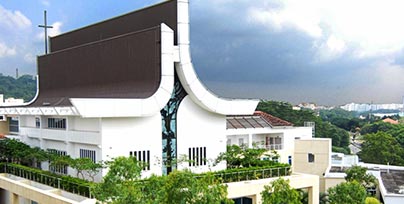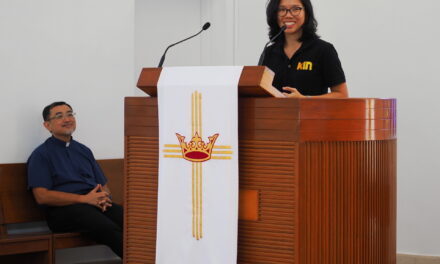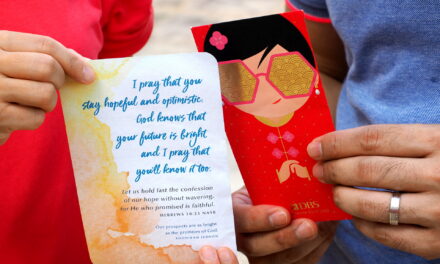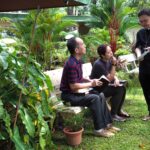
Gen 1:26-27 recounts God creating humans, male and female, in his image and according to his likeness on the sixth day. What does “created in God’s image” mean? To understand this, two aspects need to be considered: (1) how did the ancient world view images, especially images of gods, and (2) what does Genesis have to say about “image”?
In the ancient world, images of gods and kings were regarded as representatives of them. As for kings, they were regarded as being made in the divine image. Thus, kings were representatives of gods on earth. Gen 1:26-28 says that man was blessed by God with the privilege to subdue and rule over the rest of creation; ruling is clearly the role and function of a king. Psalm 8 further affirms man as being created a little lower than the angels; he was crowned with glory and made to rule the rest of creation.
While the ancient world views only kings as representatives of gods, Genesis affirms that every man and woman bears God’s image and is his representative on earth. Nevertheless, this does not mean that kings or humans resemble God physically; they only mirror God in terms of his power and prerogatives.
Gen 5:1-3 further associates God’s image in Adam with Adam’s image in Seth. John Walton suggests that a parent-child imagery is used in Gen 5 to describe man as created in God’s image. Although babies can be considered to be in the image of their parents, the resemblance will likely be no more than physical. As babies mature, based on the intrinsic image and relationship between child and parent, the image of their parents in them continues to develop. Soon, children begin to reflect the attitudes, expressions and character traits of their parents. Similarly, the parent-child imagery in Gen 5 suggests that humans have the capacity to grow in the image of God. God created us with the potential to reflect his attributes such as love, faithfulness, justice and wisdom, among many others.
In summary, being created in God’s image means that we are God’s representatives on earth with the responsibility to govern creation, and have been given the capacity to grow in God’s image and reflect his attributes to creation.
Climate change, saving the environment, creation care and other similar phrases remind us of the grim impact of our actions on the environment and the animal world. They highlight our failed responsibility in governing creation. In a recent sermon on creation care, my TTC colleague concluded by saying that creation care is “for God, for us, and forever”. The phrase “for God” urges us to move away from a human-centred view of creation; God created the world primarily for himself, not for us. God made us stewards by granting us the role of subduing and ruling over creation. The world is not ours to use as we wish but it has been put under our care to manage for God, its owner.
Imagine that you have rented your apartment out to some tenants with a list of expectations laid out in the tenancy agreement, such as servicing the air-conditioner regularly, looking after the furnishings, paying the electricity bills, while you allow them to live in and use the apartment. When the tenancy is over and you inspect your apartment, you find the kitchen cabinets damaged, the toilet bowls clogged, the curtains torn, and the furniture wrecked. How would you feel? Disappointed? Upset! Furious! Imagine how God feels about the way we have ruined his wonderful creation!
We are like the tenants, and our stewardship of the world is not just for our sake or for the sake of the rest of creation. It is primarily for God’s sake— he is the creator and owner of the whole universe. We are accountable to him for how we care for or abuse the world. Many suggestions have been made for us to practice creation care, but much more is needed, as observed by Tony Campolo:
Too often, when I read the books or listen to speeches of environmentalists who are not Christians, I recognise a basic shortcoming. Too frequently, they build their pleas for temperance and self-control on enlightened self-interest. Adopting a more environmentally responsible life-style, they point out, is the only reasonable thing to do if we know what is good for us. But much more than that is needed. We, ourselves, have to become completely different people.
Campolo’s call for us to become completely different people draws our attention to the fact that our self-centred actions can be traced to human sin. Indeed, the capacity of human beings to grow in God’s image and to reflect his attributes has been ruined by the sin of Adam and Eve, also known as the Fall. As such, God saves us not only from sin and death, he is also working to restore his image in us. Paul tells us in Rom 8:28-29 that in all things, God is working for the good of those who love him. Rom 8:29 tells us what this good is: “the good” is God’s purpose for us, which is to be conformed to Christ’s image.
Growing into Christlikeness is an ongoing, lifelong journey that involves transforming our thoughts (heads), feelings (hearts) and behaviour (hands). This transformation involves three parties: God, others and ourselves. In Col 3:1-14, Paul describes the things of the old and new selves that need to be put off and on; 3:9 states that the new self is “being renewed in knowledge in the image of its Creator”. Col 3:14 further highlights the primacy of love over all the virtues listed; Paul’s statement echoes Jesus’ greatest commandment to love God and neighbour. As Christmas draws near, may we remember that Christ came to transform us into his likeness and reflect God’s image to all of creation. Let us grow in love for God and neighbour, including creation, which is key to that transformation.

TRUMPET | Cover Story | Dec 2019









